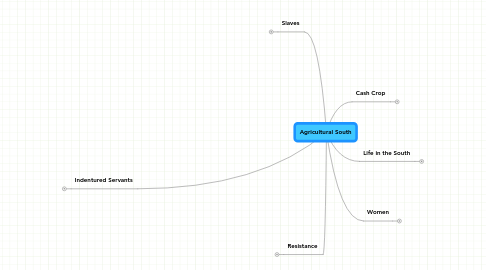
1. Indentured Servants
1.1. most traded a life of servitude or jail
1.2. young, mostly white
1.3. few rights while in bondage
1.4. those who survived were only slightly better off...moved to western outskirts
2. Slaves
2.1. people considered property of others
2.2. picked up where native americans and indentured servants left off
2.3. Slavery
2.3.1. Africans had served as slaves on sugar plantations in the West Indes for years
2.3.2. triangular trade
2.3.2.1. transatlantic trading network
2.3.2.2. New England, Africa, West Indes, Europe
2.3.3. middle passage
2.3.3.1. voyage that brought slaves across the atlantic
2.3.3.2. sickening cruelty...confined spaces, disease, branding, etc.
2.3.3.3. 20% fatality rate
2.3.4. in the south
2.3.4.1. 80 to 90% worked in the fields
2.3.4.2. 10 to 20% worked as domestics or artisans
2.3.4.3. no matter the job, cruelty
2.3.4.4. worked from 12 til death
2.4. Culture
2.4.1. spoke a variety of languages
2.4.2. wove baskets, made pottery, and made music
2.4.3. split up families started new ones, children were raised by other women
2.4.4. dance was most important
2.4.4.1. praised gods and ancestors
2.4.4.2. involved chants and quick steps
2.4.4.3. colonists tried to stop, persevered
3. Resistance
3.1. fake ilness, break tools, work slowdowns
3.2. Stono Rebellion
3.2.1. 20 slaves gathered at Stono River armed with guns and other weapons
3.2.2. killed several plantation families and marched south building numbers
3.2.3. white militia killed many and executed others
3.3. runaway notices were put in newspapers
3.3.1. runaways found refuge with the native american tribes
4. Women
4.1. few rights...could not vote or preach
4.2. taught only basic reading, writing, and math
4.3. taught social grace and domestic tasks
4.4. Average woman
4.4.1. worked in the kitchen
4.4.2. outdoor duties: milking, slaughtering, tending the garden
4.4.3. sew, washed clothes, clean
4.5. Planter class had servants to do most chores
4.6. bowed to their husbands will
5. Cash Crop
5.1. grown primarily for sale rather than farmers own use
5.2. started in Jamestown with tobacco
5.2.1. Maryland, Virginia, North Carolina
5.2.2. South Carolina and Georgia grew rice and indigo
5.3. plantations grew instead of towns
5.3.1. long deep rivers proved to be perfect highways for trade
5.4. south became very self sufficient as rural society
6. Life in the South
6.1. Diverse and $
6.1.1. Germans
6.1.1.1. Maryland to S. Carolina
6.1.1.2. raised grain, tobacco, and livestock
6.1.2. Scots and Scots-Irish
6.1.2.1. western N. Carolina
6.2. Planters controlled the south's economy
6.2.1. led to control of social institutions and politics
